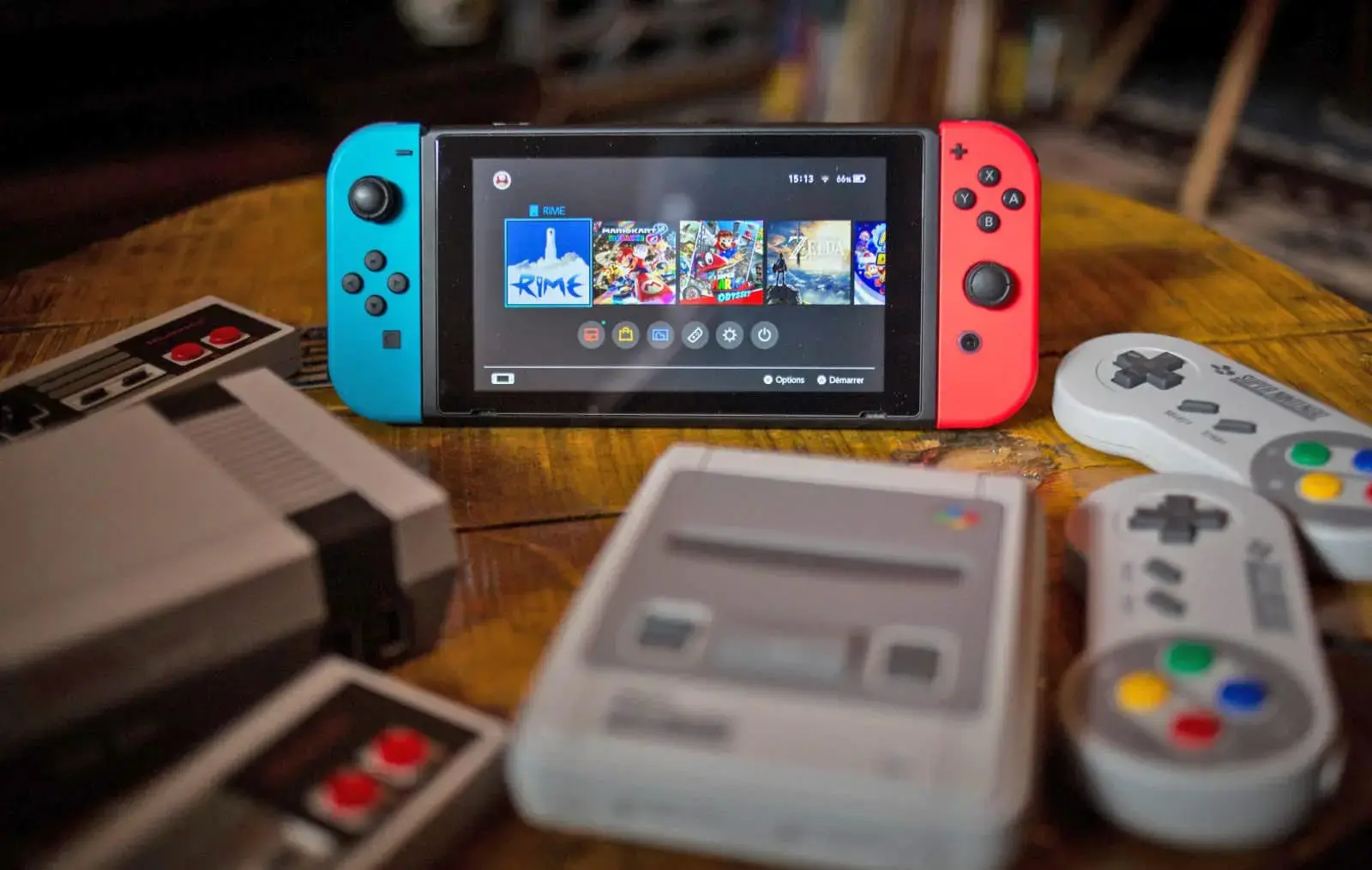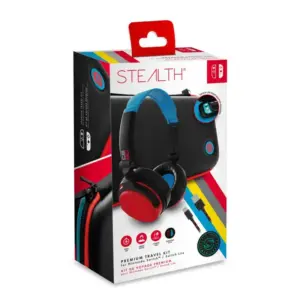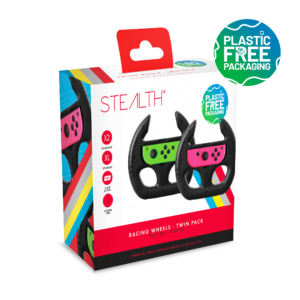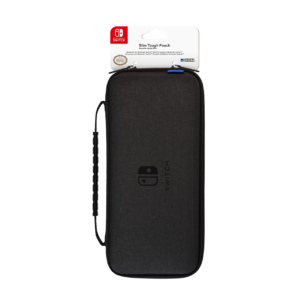History of Nintendo: Part 3 – Consoles
Not only the king of the gaming franchises, but Nintendo has also long been one of the major players on the console scene. In fact, they’ve been around for so long that they predate almost every console maker today. It’s time to jump into the time machine and fly back to the early 1980s…
Game and Watch
Nintendo started out making gaming peripherals, including the first ever light gun add-on, but it was with the Game and Watch systems that they began to make their name. At the very dawn of handheld video gaming, the Game and Watch devices were the finest in top-quality gaming equipment back in 1981.
Game and Watch worked by having a set LCD display, where a few set images would turn on and off to provide the game animation.
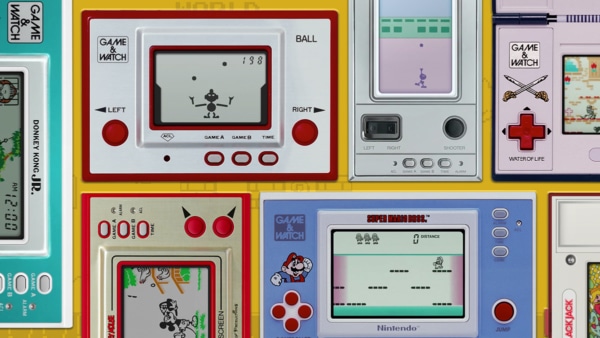
There’s a lot of great stuff that was born in the Game and Watch days, the most important being the design of the very first D-Pad controller for Donkey Kong, but other things too, such as the clam-shell design later updated for the DS, and… well… handheld gaming!
It was an impressive early achievement. Plus, celebrating the Game and Watch 40th Anniversary, Nintendo went back to these early days to release (and significantly update) the idea in 2020 with Super Mario Bros. and Zelda special editions—well worth a look.
The Nintendo Entertainment System – NES
In 1985 the world was ready for something new. In America, where the Atari 2600 had reigned supreme and brought the idea of video gaming to the masses, a string of genuinely terrible games and over-saturation of the market led to the North American Video Game Crash of 1983—in short, people in the US thought console gaming was dead.
Fresh In
Enter the NES. A worldwide rebrand of its Japanese-only Famicom console from 1983, and with Super Mario Bros. and Duck Hunt headlining its game portfolio, it stormed the American gaming world and single-handedly revitalised the industry. Games like The Legend of Zelda, Final Fantasy IV, Metroid, Kid Icarus and Excitebike followed and cemented the console into legend.
The gaming world owes quite a lot to the NES.
Game Boy
How do you make gaming better? You make it portable. In 1989, that’s exactly what Nintendo did.
The Game Boy completely and totally dominated the portable gaming market for years and years. Most famous for the astonishingly-addictive port of Tetris, Game Boys were seen everywhere. No matter the fact that they ate batteries like a hungry pygmy shrew (those things never stop eating!), the monochromatic Game Boy was the finest in handheld gaming.
The huge game library included such classics as Super Mario Land, Pokemon Red and Blue and The Legend of Zelda: Link’s Awakening. Hours and hours of fun.
A colour version in 1998 (the Game Boy Color), and then the rather cool “Advance” version in 2001 meant that Game Boys were still seen everywhere more than a decade later.
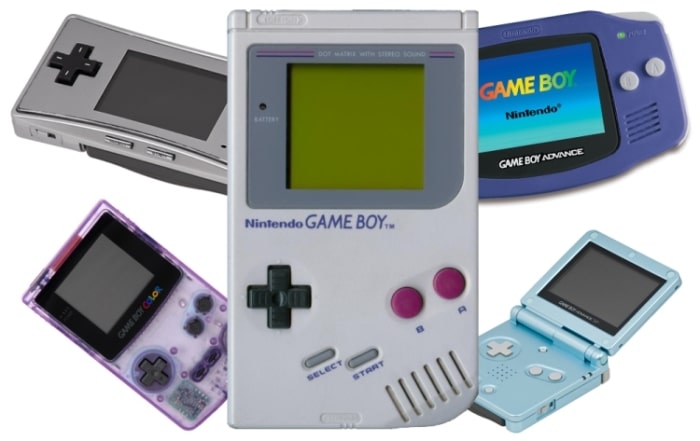
Super Nintendo Entertainment System – SNES
Back with home consoles, 1990 saw the release of the SNES. This 16-bit upgrade to the NES was in high demand everywhere and really saw Nintendo make a stamp on the European market that the NES had failed to conquer.
Famously, the SNES went up against Sega’s Megadrive (Genesis in the US) in a head-to-head console war that saw the birth of Sonic the Hedgehog for their rival. Even the mighty blue speed machine couldn’t knock Mario from his pedestal though, and the SNES came out of the debate with the trophy.
Games like Street Fighter II and Mortal Kombat brought a new generation of players to console gaming, while titles like Star Fox introduced early 3D graphics to an unsuspecting world.
Perhaps more than anything though, the SNES was known for its solid JRPG collection, with Final Fantasy games (IV, V and VI), Secret of Mana, Super Mario RPG, The Legend of Zelda: A Link to the Past and Earthbound all fighting for a crown that ultimately went to Chrono Trigger in a sweeping victory. A good time to be a fantasy fan.
Popular Products
It wasn’t all hundred-hour role-playing titles though. The SNES also brought Super Mario Kart to the world, was home to the superlative Super Metroid, and offered the latest Mario adventure in Super Mario World.
So much to enjoy, so little time!
Nintendo 64 – N64
After the incredible world-beating success of the NES, Game Boy and SNES consoles, it was inevitable that Nintendo would have to have a downturn in fortunes. There was nothing technically wrong with their next console, the Nintendo 64; in fact, there were a lot of things technically right with it, but despite some great titles the competition was just too great for Nintendo to defend their reign.
The N64 went up against the very first PlayStation in an arena that had already become overwhelmed by Sony’s first flagship console. The PlayStation came out in late 1994/early 1995 (depending on territory) and the N64 didn’t see the light of day until 1996. That year was enough for Sony to claim the love of gamers everywhere.
It didn’t hurt Sony that the Playstation was a fantastic console with an incredible collection of games.
Nintendo still had a few aces up their sleeve, of course. Proprietary first-party titles such as Super Mario 64 and Mario Kart 64 meant that the console would definitely sell among fans, and it brought new and original titles like Super Smash Bros. to the world.
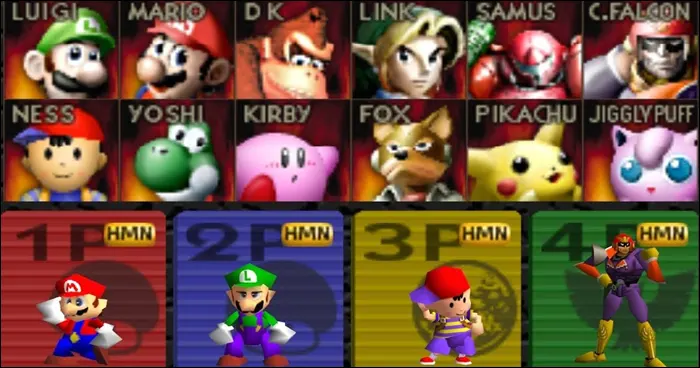
The top contenders though, and the two titles for which the N64 will forever be remembered are the incredible multi-player James Bond shooter Goldeneye 007 (much better than the film it is tied to), and the mind-blowing wonder that is The Legend of Zelda: Ocarina of Time—both games that were worth buying the console for.
Still, it was a definite slide down for Nintendo as market share went convincingly Sony’s way.
Nintendo GameCube
If the N64 had lost ground in the mid-90s, it was nothing compared to the tumble that came at the dawn of the twenty-first century. 2001 saw the GameCube launched against the PlayStation 2 and the first Microsoft Xbox. Yet again, Sony was a year ahead of the competition, and the PS2 held onto its user base from the first console as well as picking up plenty more.
Nintendo’s cute purple cube (it wasn’t even really a cube…) with its minidiscs and toy-like aesthetic never stood a chance.
Even the games failed to rekindle that top-quality Nintendo feel. Sure, there were plenty that was good, but nothing rocked the world—and certainly very little was felt outside of the fanbase. Metroid Prime proved to be incredible, despite some scepticism at the time, and new franchises like Animal Crossing soon gathered a following, but even the console’s Zelda and Mario titles felt lacklustre.
Fresh In
Ironically, one of the more enthused titles for the GameCube came from former rivals Sega. If Sony had dented Nintendo’s console market share, they had totally destroyed Sega’s. Withdrawing from the hardware scene, Sega decided to focus on being a game developer and released Super Monkey Ball on the GameCube. It was the perfect blend of cartoony casual fun that has long been loved by Nintendo fans and the crazy ball-rolling game became a mini-phenomenon at the time. Still, not enough to save Nintendo here, and the GameCube lost yet more ground.
Nintendo DS
Returning to an arena where they really did know their stuff, in 2004, Nintendo released a new handheld to replace its ageing Gameboy. With two screens, one of which was a touchscreen, and a clamshell design reminiscent of the best Game and Watch games, the Nintendo DS was destined for great things.
Even “great” is an understatement.
In all its iterations, which include the fabulous DS Lite, the DSi, 3DS, 2DS and more, the Nintendo DS has sold more than any other console in existence except for the PlayStation 2 (and it was a close thing).
The console’s handheld design was (and still is) fantastic. It was the first truly rechargeable mainstream handheld, a huge benefit, and the games ranged across all genres to provide a portable, top-quality, gaming experience for everyone.
There’s little doubt that the DS saved Nintendo’s fortunes at the time, catapulting them back into worldwide recognition.
Games for the DS, each worth getting the system for, include The World Ends With You, Phoenix Wright: Ace Attorney, Dragon Quest IX: Sentinels of the Starry Skies, Pokemon Black and White, Animal Crossing: Wild World, Rhythm Paradise, Professor Leyton and the Curious Village, Mario and Luigi: Bowser’s Inside Story, plus of course, New Super Mario Bros. and Mario Kart DS.
Oh, and the improved Chrono Trigger, back from its SNES days and every bit as brilliant.
Phew!
Wii
If Nintendo were ever going to reach the top home console spot again, they needed to do something new, something innovative. It wasn’t like they didn’t have a track record for innovation, but could they pull something else out of their bag of tricks?
In 2006, with the Wii, they proved they could.
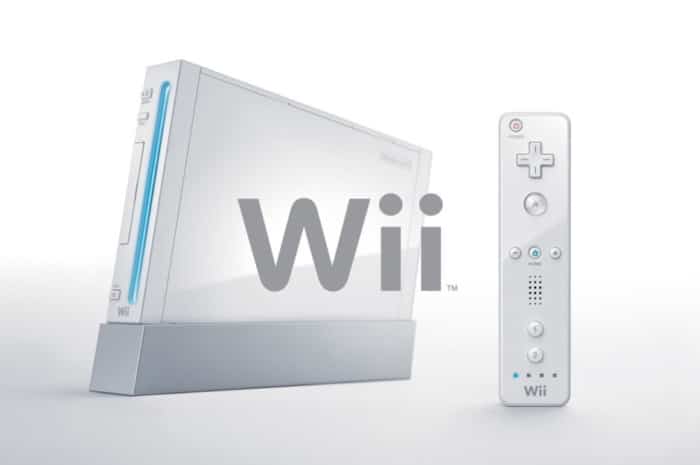
Realising that they couldn’t compete on technical specifications, the arena that was being hard-fought between Sony and Microsoft, Nintendo turned back towards something they knew best: fun.
By the time the 2000s had settled in, the game industry was in danger of losing its way. Rather than focussing on enjoyment, games had started to become little more than very impressive technology demonstrations. High definition graphics, faster frame rates, and impressive massively-multiplayer connections had become the norm, but somewhere in there, the sheer reason for playing had gone. People weren’t simply sitting down for a bit of fun anymore, gaming had become serious.
Nintendo waded into that pool with the Wii. A relatively-tiny white plastic box which couldn’t push out more than 480p resolution and was also saddled with a really dumb name—by conventional wisdom, the Wii should have been the third in a series of home console misses. Instead, it hit home like a baseball whizzing through the air in Wii Sports.
Ah yes, Wii Sports. The game bundled with the Wii was developed really to showcase the new motion controllers (haven’t we mentioned those yet) and was responsible for a whole new round of Nintendo fandom. Rather than looking like a Mario game, Wii Sports introduced us to the Mii, a self-portrait style avatar that gave you, the player, a different connection to the game. It was genius.
Popular Products
With superb motion controls, an innovative avatar system, and a ton of family-oriented games that really could be enjoyed by any age group (as proven by the number of kids competing in Mii-oriented tennis matches against their grandparents); the Wii was Nintendo at its finest.
Not everyone wanted one—the serious gamers with their PS3s and Xbox 360s laughed at it—but enough people did. Plus, importantly, a lot of the people that did had not ever owned a console before. Nintendo opened up a whole new audience. They didn’t try to take market share back—they knew that was impossible—instead, they simply made a whole new market.
Brilliant.
Of course, Wii Sports, wasn’t the finest Wii title, even if it was single-handedly responsible for a surge of players. No, the Wii kept giving with brilliant moments like Mario Kart Wii (complete with plastic steering wheel accessory), Super Mario Galaxy (1 and 2), Super Smash Bros. Brawl, The Legend of Zelda: Skyward Sword, A Boy and His Blob, Donkey Kong Country Returns, Boom Blox Bash Party, Xenoblade Chronicles, Metroid Prime 3, and a return to the 2D platforming masterpiece with New Super Mario Bros. Wii.
Plus Wii Fit with its unique balance board, an accessory that sold nearly as many units as the console itself!
A true triumph.
Wii U
The higher you climb, the harder you fall. The Wii U, six years later in 2012, was a complete flop.
Poorly marketed (people thought it was an add-on to the Wii), badly defined (was it a home console, was it a handhold?), and with no real defining games, the HD-enabled Wii U just couldn’t repeat the success of its predecessor.
There’s plenty that can be said about the console, like how it might have been a hundred times more successful if they’d just called it the Wii 2, but only one thing is important: it was a stepping stone to what came next.
Games? There are a few standouts, notably Super Mario 3D World, Super Mario Maker, and the first of a new franchise–Splatoon. But, most of the games worth playing were very quickly ported onto the next console.
Oh, the next console, the next console. Why are we even bothering to talk about the Wii U?
Nintendo Switch
Is it possible to make a handheld system to beat the DS?
Can a home console be made to be more successful for Nintendo than the Wii?
Can it be the same device?
Of course!
The Nintendo Switch arrived in 2017 and has steadily climbed and climbed ever since, outselling the Wii and approaching the vaunted heights of the Game Boy and DS systems.
Creating a console that has the motion controls of the Wii (somewhat improved), the handheld playability of the DS (with a far superior screen), and the ability to plug it into a base station for home-TV play (prototyped by the Wii U), and an online library of games that includes the finest of everything that came before it… well, it was bound to do quite well.
The Switch is an incredible console. No, it doesn’t have the technical specs to go up against its direct rivals from Sony and Microsoft (quite honestly, comparing it in that way to a PS5 or Xbox Series X is a joke), but Nintendo learned from the Wii that they don’t have to. They just have to make a great gaming experience.
They released The Legend of Zelda: Breath of the Wild, often cited as the best game of all time.
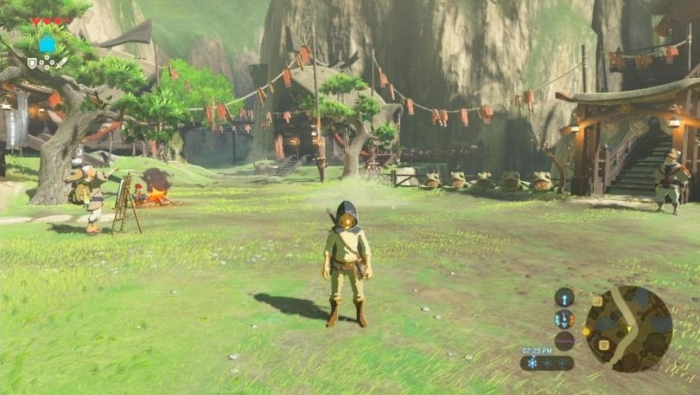
They added Mario Kart 8 Deluxe, the best version of the world’s favourite racing game.
They very quickly brought Spatoon 2 to the fray.
They blew the casual gaming world wide open with Animal Crossing: New Horizons.
And it goes on. Luigi’s Mansion 3, Metroid Dread, Super Mario Odyssey, Super Smash Bros. Ultimate, Hollow Knight, a Mario-themed Minecraft, Fire Emblem: Three Houses… The library of good Switch titles is endless and with more solid games being released every week, it doesn’t look like anyone is going to run out of fun anytime soon.
The Future…
Despite all the powerful competition, Nintendo has shown that they know exactly what they are doing when it comes to making and supporting the most enjoyable video games in the world. Even with the occasional knockback, this is a company that has constantly innovated and impressed the world, and they’re currently at the very top of their game.
Can they go higher? We certainly think so.
No one outside of Nintendo really knows what’s next for the company. With the Switch well-established and doubtless into the middle of its lifespan, there’s no doubt that something is brewing, though it could be years before we see it.
Whatever it is though, we know it’s going to be great. Until then, there’s so much to still play.

